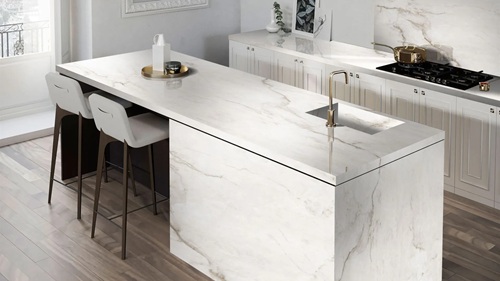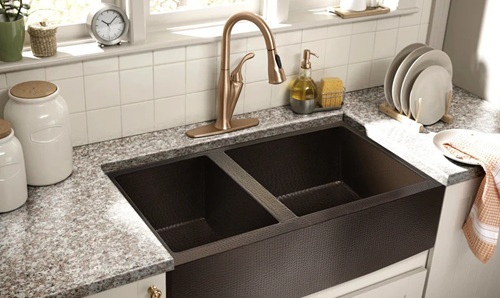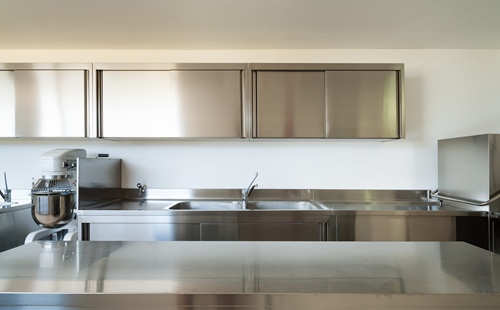Porcelain is best known for its use in tiles and ceramics, but over the past decade, it has carved out a niche in high-end kitchen design—especially in the form of porcelain kitchen countertops. Durable, stylish, and heat-resistant, porcelain slabs offer a compelling alternative to granite, quartz, and marble.
Lets explores the pros and cons of porcelain kitchen countertops—covering everything from durability and aesthetics to maintenance and cost—so you can determine whether porcelain is the right fit for your kitchen upgrade.

What Are Porcelain Countertops?
Porcelain is a type of ceramic made by firing kaolinite clay at extremely high temperatures (up to 1,400°C or 2,500°F), which makes it hard, dense, non-porous, and heat-resistant.
Porcelain countertops are typically made from thin, large-format slabs (often 6–12 mm thick) that are reinforced and printed with advanced technology to resemble materials like marble, wood, concrete, or metal. These slabs are often imported from Europe, especially Italy and Spain.
✅ Pros of Porcelain Kitchen Countertops
1. High Heat Resistance
Porcelain is extremely heat resistant, meaning you can place hot pans or baking trays directly on the surface without fear of burning or discoloration. This feature is a game-changer for avid cooks and bakers.
Fact: Porcelain is fired at over 2,500°F—hotter than anything your kitchen can dish out.
2. Stain and Chemical Resistance
Because porcelain is non-porous, it’s naturally resistant to stains, even from acidic substances like lemon juice, red wine, coffee, or vinegar. It also resists household chemicals, unlike marble or granite.
Pro Tip: Great for homes where spills are frequent or deep cleaning is a regular occurrence.
3. Scratch and UV Resistance
Porcelain ranks high on the Mohs hardness scale, making it highly resistant to scratches from knives, pots, or abrasive cleaners. It’s also UV-resistant, meaning it won’t fade or discolor over time when exposed to sunlight—ideal for bright, open kitchens.
4. Low Maintenance
Unlike natural stones, porcelain does not require sealing, polishing, or refinishing. A simple wipe-down with mild soap and water keeps it looking new.
Maintenance Score: 10/10 for low-effort homeowners.
5. Variety of Colors and Patterns
Thanks to inkjet printing technology, porcelain slabs can realistically mimic marble, granite, wood grain, concrete, or even metallic surfaces. You get the aesthetic of luxury materials without their vulnerabilities.
Design Tip: A Calacatta marble-look porcelain slab pairs beautifully with matte black fixtures for a modern European kitchen vibe.
6. Environmentally Friendly
Porcelain is made from natural materials and is 100% recyclable. It also releases no VOCs (Volatile Organic Compounds), making it a safer, greener choice for indoor air quality.
❌ Cons of Porcelain Kitchen Countertops
1. Can Chip or Crack at the Edges
While porcelain is hard, it’s also brittle, especially around the edges and corners. Heavy impact—like dropping a cast iron pan—can chip or crack the material more easily than quartz or granite.
Pro Tip: Be extra cautious around overhanging edges and consider rounded corners for better durability.
2. Limited Thickness Options
Porcelain countertops are generally much thinner than granite or quartz slabs (typically 6–12 mm). While this sleek profile suits modern kitchens, it may lack the visual weight some homeowners prefer.
To address this, installers may miter the edges to give the illusion of thickness—but this increases fabrication complexity and cost.
3. More Complex Installation
Due to its brittle nature and large format, porcelain requires special tools and skilled labor for fabrication and installation. Improper handling during cutting or transport can lead to cracks.
Warning: Not every countertop fabricator has experience with porcelain—choose your installer carefully.
4. Higher Initial Cost
Though less expensive than premium marble or some quartz options, porcelain countertops tend to be more expensive than laminate, butcher block, or lower-end granite.
Estimated Cost (Installed):
- USA: $60–$120 per sq. ft.
- India: ₹3,000–₹6,000 per sq. ft.
The price reflects the material, fabrication, and complexity of installation.
5. Limited Edge Profile Options
Due to its thinness and brittleness, porcelain countertops can’t be sculpted into detailed edge profiles like ogee or bullnose. Most installations stick to square, mitered, or beveled edges—ideal for modern but not traditional styles.
Porcelain vs Other Countertop Materials
| Feature | Porcelain | Quartz | Granite | Marble | Laminate |
| Heat Resistance | Excellent | Moderate | Excellent | Moderate | Poor |
| Stain Resistance | Excellent | High | Moderate | Low | Moderate |
| Scratch Resistance | Excellent | High | High | Low | Low |
| UV Resistance | Excellent | Poor | Moderate | Poor | Poor |
| Maintenance | Low | Low | Moderate | High | Low |
| Customization | Moderate | High | High | High | High |
| Cost (Installed) | Medium–High | Medium–High | Medium–High | High | Low |
| Durability | High (with care) | Very High | Very High | Moderate | Moderate |
Best Practices for Porcelain Countertops
- Choose Experienced Installers – Ensure your fabricator specializes in porcelain slabs for proper cutting and installation.
- Use Edge Protection – Consider slightly rounded or mitered edges to reduce chipping risks.
- Avoid Extreme Impact – Don’t drop heavy pots or tools directly on edges or corners.
- Clean With Care – Use mild soap and non-abrasive cloths for everyday cleaning.
- Seal the Seams – Seam lines in porcelain are often visible; make sure they are tightly sealed and color-matched.
Is Porcelain the Right Choice for Your Kitchen?
✅ Porcelain Countertops Are Perfect If:
- You want a low-maintenance, stain-proof surface.
- Your kitchen receives a lot of natural light and needs UV-resistant materials.
- You love the look of marble or stone but want a more durable alternative.
- You cook frequently and need a heat-resistant and hygienic surface.
❌ Porcelain May Not Be Ideal If:
- You prefer detailed or ornate countertop edges.
- You have a high-impact kitchen with frequent heavy-object use.
- You want a thick, traditional countertop appearance.
- You’re on a tight remodeling budget.
Final Verdict
Porcelain kitchen countertops offer a sleek, ultra-durable, and low-maintenance option for modern kitchens. With exceptional resistance to heat, stains, scratches, and UV rays, porcelain outperforms many traditional materials—especially in busy households or sun-filled kitchens.
However, its thin profile, susceptibility to chipping, and higher installation complexity make it less suitable for rough handling or elaborate designs. If you’re looking for a countertop that combines aesthetics, hygiene, and resilience with minimal upkeep, porcelain is a premium option worth considering.

